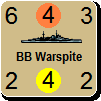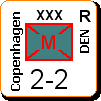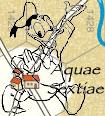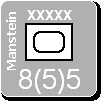warspite1
Posts: 41353
Joined: 2/2/2008
From: England
Status: offline

|
Having just come back from a humbling visit to Westminster Abbey and a trip to see the Garden of Remembrance (shrouded in Poppies and crosses, stars of St David etc) and The Tomb of the Unknown Warrior, I feel the need to post a Royal Navy write-up and to say thank you  . .
[4583 Hood - by Robert Jenkins]
.B Engine(s) output: 144,000 hp
.B Top Speed: 31 knots
.B Main armament: 8 x 15-inch (381mm), 14 x 4-inch (102mm) AA guns
.B Displacement (full load): 46,200 tons
.B Thickest armour: 12-inch (Belt)
.P HMS Hood or the "Mighty Hood" was the last battlecruiser built for the
Royal Navy (RN). The RN wanted a class of four, fast, lightly armoured but
powerfully armed ships and the original design was completed before the fleet
encounter at Jutland in 1916. At Jutland the deficiencies in the battlecruiser
concept were exposed when the RN had three such ships blow up with huge loss of
life. As a result, the design for this class was altered to allow for additional
armour.
.P Despite this re-design, Hood`s three planned sister ships were cancelled at
the end of World War I and infact Hood was only completed to enable the RN to
gain experience of a number of new features she would test.
.P Her increased armour and other modifications received between the wars meant
that she sat considerably lower in the water than originally intended. This gave
her a reputation as a wet ship, although in fact, she proved a stable gun
platform for her excellent 15-inch main armament, of which she was fitted with
eight, in four twin turrets.
.P Hood combined elegant design with impressive size and between the wars, she
was a great success in "showing the flag" around the world. It could be argued
that her reputation was allowed to cloud peoples mind to the reality of her
design shortcomings; and not just in the Admiralty. It is interesting to hear the
views from survivors of the Bismarck as to how Hood was truly feared by the
Kriegsmarine.
.P Although she had numerous upgrades during her life, Hood only had one major
refit and that was at the end of the twenties. During the thirties it was
realised that she needed a major overhaul. This would have included replacement
of her machinery and a significant strengthening of her horizontal armour, which
was spread too thin and so did not provide protection where it was most needed.
Finally, in an effort to improve her anti-aircraft (AA) weaponry, she would have
had all secondary guns removed in favour of eight, twin, dual-purpose 5.25-inch
turrets and six, 8-barrel pompoms.
.P She was earmarked to follow the battleship Queen Elizabeth and to be the next
in line for a major modernisation. Unfortunately, the outbreak of World War II
meant that this never happened and as a result the Hood that was sent in May 1941
to intercept and stop the Bismarck - Germany`s newest operational battleship -
was little changed from the battlecruiser, designed during World War I.
.P The four ships of the class were all to have been named after famous Admirals
of the RN: Hood, Rodney, Howe and Anson, with Hood named after Samuel Hood,
famous for his exploits in the French Revolutionary Wars and the American War of
Independence.
.P HMS Hood was completed in May 1920. At the outbreak of World War II she was
part of the 1st Battlecruiser Squadron, Home Fleet, along with the Renown and the
Repulse. Initially she was deployed on convoy defence and patrol and
interception duties in the North Western Approaches. She came under air attack
for the first time on the 26th September, while escorting the damaged submarine
Spearfish back to the UK (see Submarine Counter 4734). She received slight
damage from a 500lb bomb during this action. In October, she took part in an
unsuccessful search for the German battlecruiser Gneisenau and the cruiser Köln
off the Norwegian coast (see HMS Repulse) and the following month she was part
of the Home Fleet that screened the return of an Iron Ore Convoy from Narvik,
escorted by the cruiser Aurora and four destroyers. Hood then took part in the
unsuccessful search for Gneisenau and her sister Scharnhorst, after the sinking
of the armed merchant cruiser Rawalpindi (see ASW Counter 4698 and HMS
Newcastle). At the end of the year and into 1940, Hood was one of the ships
tasked with escorting the Canadian troop convoys into home waters, and she mixed
this duty with continued patrol and interception work.
.P At the end of March 1940 Hood underwent a refit, during which she had her
remaining 5.5-inch secondary armament removed, and upon completion, she was
selected to join the newly formed Force H, as Flagship of Admiral Somerville (see
HMS Enterprise). Force H was based in Gibraltar, and Hood escorted military
convoy US.3 on her way there (see Transport Counter 4717). At the beginning of
July, Hood had the unenviable duty to lead Force H in the attack on the Vichy-
French Fleet at Mers-El-Kebir (see HMS Enterprise). At the end of that month, she
took part in Hurry; an operation to deliver fighter aircraft to Malta (see HMS
Argus). This was her last operation as part of Force H, and she returned to the
UK at the start of August, being replaced in Force H by Renown.
.P Hood was returned to the Home Fleet to undertake both anti-invasion patrol
and also interception duties. In November she was sent to try and intercept the
Admiral Scheer after the sinking of the Jervis Bay (see ASW Counter 4698) but no
engagement ensued. January 1941 saw her receive a refit for the purpose of
fitting her with radar, and her first role upon her return was to deploy south
of Iceland to guard against the possibility of Scharnhorst and Gneisenau escaping
back to Germany, following their break-out (see HMS Nelson).
.P Then in May, Hood was to take part in her final operation. The German
battleship Bismarck and her heavy cruiser escort Prinz Eugen, attempted to break-
out into the Atlantic, where they would seek to inflict as much damage and
disruption against the Atlantic convoy routes as possible. The German ships used
the Denmark Strait as their gateway. However, the heavy cruisers Norfolk and
Suffolk were patrolling in that area and managed to pick the German ships up on
radar. The cruisers were able to keep track of the enemy and this enabled Hood
and the new battleship, Prince of Wales, to sail to intercept. The British ships
were under the command of Vice-Admiral Holland in Hood.
.P On the 24th May, the RN ships were sailing at 29 knots, with Prince of Wales
roughly 800 yards to the right and rear of Hood. When contact was made, the
German ships had "crossed the T" and so were able to bring all their main
armament to bear against the RN ships, which had the use of just their forward
guns. Holland decided to close the range as quickly as possible before turning at
short range to bring his rear guns into the battle. He knew that at closer range
the Hood would be less susceptible to plunging shells; her big weakness given the
lack of horizontal armour over her vital areas. Hood opened the firing at 0552hrs
that morning at a range of just over 25,000 yards.
.P When the order to engage was given, Prinz Eugen was mistakenly made the target
by both British ships. Captain Leach, aboard the Prince of Wales, realised the
error but for reasons unknown, Hood apparently failed to change target. However
this is subject to debate as survivors from Bismarck insist Hood had engaged them
that morning. Whatever the truth, Hood failed to hit either ship. Curiously, the
commander of the German fleet, Admiral Lütjens, aboard the Bismarck, was slow in
ordering fire to be returned and Bismarck`s captain, Ernst Lindemann was the one
that gave the order, allegedly declaring, "I will not let my ship get shot out
from under my arse!". Both German ships then concentrated their fire on the Hood.
.P It is believed that the first hit on the battlecruiser came from the 8-inch
shells of Prinz Eugen rather than from Bismarck, whose first three salvoes
missed. A hit on Hood started a fire that spread across the boat-deck and reached
the ready-use ammunition lockers. The boat-deck soon became an inferno as 4-inch
shells and 7-inch UP rocket mines began detonating. Holland ordered that the
fire be left until the ammunition had all detonated in order to ensure the safety
of the damage control parties. A shell then passed through Hood`s spotting top
and this further reduced her ability to accurately fire back.
.P Bismarck used her secondary armament against the Prince of Wales, but kept
her main guns ranged against Hood. Prinz Eugen switched fire to Prince of Wales
after her 6th salvo. Prince of Wales meanwhile continued to fire at Bismarck.
As mentioned previously, it cannot be certain which ship Hood was firing at, but
her shells were still missing both enemy vessels and the RN ships were now in
serious trouble. The enemy had found their range and so as soon as he believed it
safe to do so, Holland gave the order to turn his ships to port and allow the
rear guns into action. The moment the turn began, disaster struck. According to
Captain Leach, Bismarck’s 5th salvo had hit around the base of Hood`s mainmast.
Within a second or two, there was a huge explosion, with a thin, funnel shaped
flame shooting out from the boat-deck. This was followed by her being covered in
smoke. Hood rolled to port and began to sink very quickly, breaking in two as she
did so. It was less than nine minutes since the battle had commenced.
.P Meanwhile, the Prince of Wales had completed her turn to port and now found
herself sailing directly for what remained of the Hood. She took immediate
evasive action to avoid the wreckage, ceasing firing momentarily as she did so.
Because the two RN ships were sailing so close, the Bismarck was easily able to
switch fire accurately to Prince of Wales, and the battleship was lucky to
survive a 15-inch hit underneath her armour belt, when the shell failed to
explode. She also took a direct hit against her bridge that killed all men there
with the exception of two, one of whom was Captain Leach.
.P However, Bismarck was not having it all her own way and the Prince of Wales
scored three hits, one of which was against a forward oil tank and this was to
force Lütjens to cancel his mission and head for France. Prince of Wales laid a
smoke screen and broke off the engagement as she was having problems with her
main armament. Lütjens refused to allow his ships to pursue her, and at 0609hrs,
the Germans ceased firing.
.P The exact cause of the loss of the Hood will probably never be known. The
most likely explanation is that a 15-inch shell from the Bismarck penetrated her
4-inch magazine which then blew the ship apart. Regardless of the exact cause,
the fact remains that out of a crew of 1,418 men, only three survived. A tragic
end to a famous ship.
.P Although the Hood was gone and the Prince of Wales out of action, the hunt for
the Bismarck was only just starting (see HMS Rodney).
< Message edited by warspite1 -- 11/13/2009 6:59:52 AM >
_____________________________
England expects that every man will do his duty. Horatio Nelson October 1805  |
 Printable Version
Printable Version







 . This is the sort of detail I am lacking for the Japanese generally.
. This is the sort of detail I am lacking for the Japanese generally.  FOr example, the Hyuga arrives as a reinforcement in Nov/Dec 1943. I assume that should be the replacement. Similarly, the Hyuga that sets up in Decline and Fall should also be the replacement. Yes?
FOr example, the Hyuga arrives as a reinforcement in Nov/Dec 1943. I assume that should be the replacement. Similarly, the Hyuga that sets up in Decline and Fall should also be the replacement. Yes?

 this time).
this time).  .
. 


 New Messages
New Messages No New Messages
No New Messages Hot Topic w/ New Messages
Hot Topic w/ New Messages Hot Topic w/o New Messages
Hot Topic w/o New Messages Locked w/ New Messages
Locked w/ New Messages Locked w/o New Messages
Locked w/o New Messages Post New Thread
Post New Thread